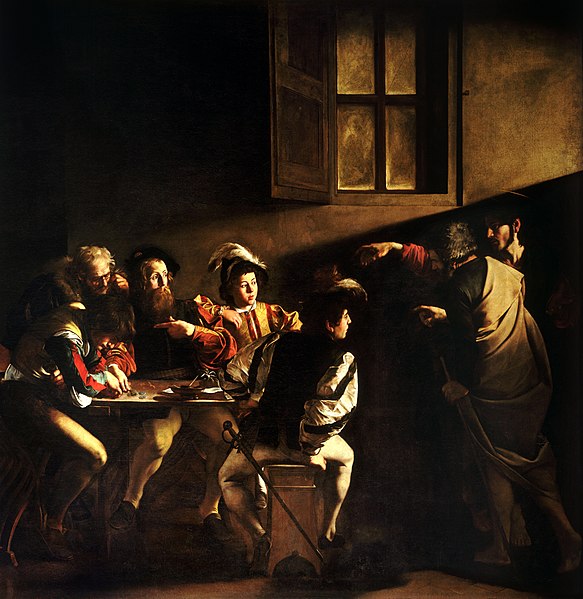|
The Calling of Saint Matthew, by Michelangelo Merisi da Caravaggio The hustle and bustle of Piazza Navona evaporated in the coolness and silence inside San Luigi dei Francesi, a church near my Aunt Barbara’s apartment in Rome. I followed my aunt and parents through the opulent sanctuary to a darkened chapel within the church. A musky smell and the scent of candles lingered in the air. Barbara dropped lira coins in a metal box outside the Contarelli Chapel. Clink, clink, and the lights turned on. My parents gasped when the lights revealed a trio of paintings by Caravaggio. The world-renowned works by the Baroque master about the life of St. Matthew didn’t interest me. Oh great, my favourite, more religious art. I kept my sarcasm to myself, as I often did since turning thirteen. My parents and aunt seemed intent on visiting every church in Rome. I glanced at the second painting above the altar. I flinched and averted my gaze at the violence in The Martyrdom of Saint Matthew, which depicted St. Matthew’s murder by a soldier. The Inspiration of Saint Matthew featured a bald and bearded man in an orange robe writing seated at his desk with an angel over his shoulder. Boring. I paused before The Calling of Saint Matthew on the opposite wall. In a dark room, five men sat at a wooden table. The bearded man pointed at himself. At the head of the table, another man slumped. Two men stood before them. Barbara joined me. “Do you know the story from the Gospel of Matthew?” When I shrugged, she told me how Jesus inspired Matthew, a tax collector, to follow him. She explained the standing man pointing was Jesus, and the bearded man pointing at himself was Matthew. The religious story behind the painting didn’t interest me, but I continued to be impressed by my aunt’s knowledge of Roman history, architecture, and art. Plus, on daily shopping trips to the local markets, she chatted in effortless, melodic Italian with the vendors. She seemed so cosmopolitan compared to the adults I knew in my rural Minnesota hometown. A beam of light in the painting illuminated the seated men’s faces. I stood transfixed, unable to take my eyes off of the masterpiece. I had never appreciated art, especially a piece of religious art, until that moment. Barbara pointed to the bright shaft of light, the same way Jesus gestured at Matthew. “Caravaggio is known for chiaroscuro.” I crossed my arms in front of me and gazed upon Matthew’s awakening. “What’s that?” “The bold contrast of light and dark.” Barbara’s immersion and understanding of the local culture brought Rome and the sites we visited to life for me in the same way Caravaggio illuminated his subjects. “It makes the people look three-dimensional.” As we exited the church, I bought a postcard of the masterpiece, which was high praise from me at age thirteen. The postcard is long gone. Years later, my memories of Roman sites we visited crumbled like ancient ruins. The transcendent experience of standing before The Calling of Saint Matthew remains clear, like a piece of art restored to its original condition. Kelsey Cleveland Kelsey Cleveland is currently working on a travel memoir, Waving Hello, Bowing Goodbye: A Dual Love Story with Japan and a Man. She now resides with her husband and teenage son outside Portland, Oregon, where her passport is safely stowed for now.
0 Comments
Your comment will be posted after it is approved.
Leave a Reply. |
The Ekphrastic Review
COOKIES/PRIVACY
This site uses cookies to deliver your best navigation experience this time and next. Continuing here means you consent to cookies. Thank you. Join us on Facebook:
July 2024
|




